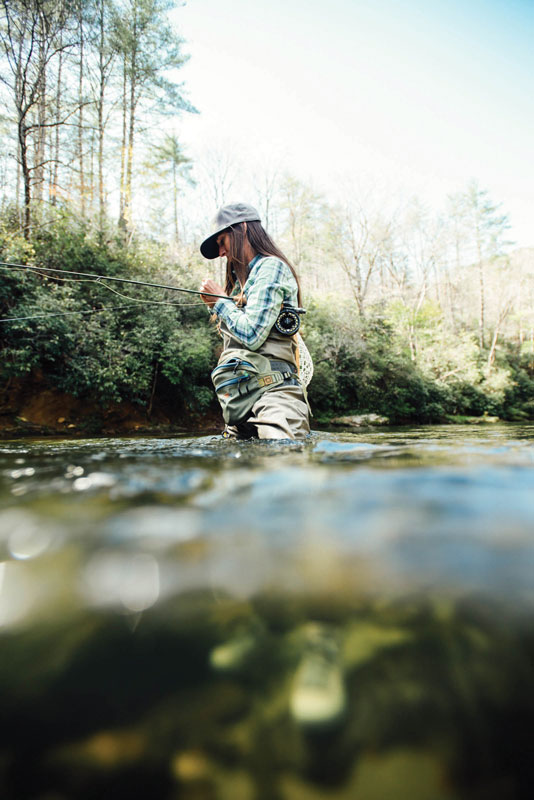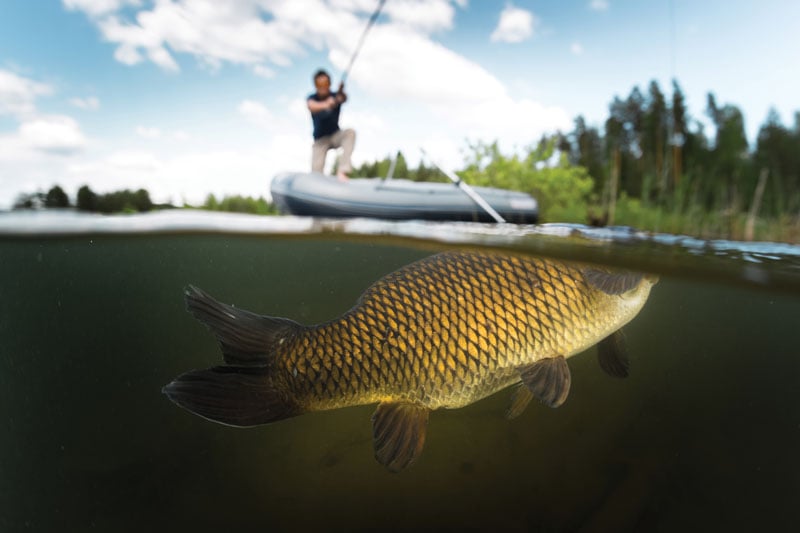Seven Destinations To Get In On The Action
There’s a brutish undercurrent gaining momentum in fly fishing. Across the Southeast and Mid-Atlantic, anglers are taking the delicate tools and techniques traditionally associated with surface-sipping trout, and they’re adapting them to pursue warmwater fish.
While fly fishing for bass and bream is not new, this evolution toward larger, more powerful species has accelerated over the last decade. It is driven by anglers seeking a thrill more visceral than pretty little rainbows on mountain streams.
From river-run striped bass to muskie, black bass and carp, fly-rodders are developing new ways to catch freshwater’s most powerful fish. Here are seven destinations to do battle with fish that break hearts and fishing rods.
James River Muskie, Virginia
The James River is one of the few rivers in the east that supports a fishable wild muskie population. Virginia tapered off stockings about a decade ago, and the river’s muskellunge are thriving.
Guide Matt Miles eagerly pointed out that most of the fish they catch, the 35- to 42-inchers, were spawned in the upper James. He said the monster 50-inchers might have originally come from the hatchery, but they still prowl the river, ready to give anglers the adrenaline rush of a lifetime.
Between Iron Gate and Lynchburg, Va., more than 80 miles of the James are considered muskie water. The relatively shallow pool and riffle habitat is uniquely suited to hunting freshwater’s biggest, toothiest fish with a fly rod.
But muskie fishing isn’t for everyone. Casting waterlogged, 8- to 14-inch-long streamers on sinking lines with 10- and 11-weight rods is a workout. Doing it all day in hope of a single take requires mental fortitude.
“Muskie fishing is about being in the right place at the right time,” Miles said. “I can put you in the right place and teach you the right way to do it. I can’t make it the right time. So much depends on the conditions and the way the fish are acting.”
Peak muskie season is October through mid-March, and if the 50/50 odds of drawing a strike seem a little slim, the James is also an excellent smallmouth river.
Guides/Information: Matt Miles Fly Fishing, (434) 238-2720, mattmilesflyfishing.com.
Greenbrier River Smallmouth, West Virginia
Fed by trout streams of the 900,000-acre Monongahela National Forest and flowing unchecked for 173 miles through the gorgeous Alleghenies of eastern West Virginia, the Greenbrier River quietly dishes out some of the best smallmouth bass fishing in the region.
Jacob Ott, director of outdoor pursuits at the venerable Greenbrier Resort in White Sulphur Springs, W.V., singled out the Greenbrier as his top choice for smallies on the fly. He said competent anglers catch 15 to 25 bass on a half-day float trip, and trophy fish longer than 20 inches are a definite possibility. The largest fly-caught bronzeback he’s ever guided a client to—a massive 26-incher—was caught on the lower end of the Greenbrier.
Fishing is best May through October, when an outstanding topwater bite can arise at any time. Chugging poppers through bank eddies incites violent blow-ups if the fish are looking up. If they’re feeding sub-surface, Greenbrier smallmouths slam crayfish and baitfish patterns.
The Greenbrier also offers incredible access. With numerous put-ins and take-outs for hand-launched boats as well as two concrete boat ramps, biting off a stretch to float is not a problem. For wading anglers, the 77-mile state-owned Greenbrier River Trail between the towns of Cass and Caldwell offers unparalleled access by foot, horse or mountain bike.
Guides/Information: Jacob Ott, (304) 667-8337, [email protected]; Serenity Now Outfitters, (304) 647-9779, serenitynowoutfitters.com.

French Broad & Holston River Smallmouth, Tennessee
East of Knoxville, Tenn., the French Broad and Holston rivers make a final run to their confluence and the formation of the mighty Tennessee River. Fly fishers might be familiar with these two rivers for the trout they offer farther upstream. This low in the system, they are smallmouth bass factories.
Bill Stranahan, with Southeastern Anglers Guide Service, treats the French Broad and Holston as a single destination. Low or falling flows are preferable for fishing these dam-driven tailwaters, and one or the other typically offers optimal conditions on a given day. Their proximity allows for a game-time decision from more than 60 miles of prime smallmouth water.
The habitats are similar, with a good variety of shoals, cobblestone shallows and gravel bars to fish. This structure is interspersed between long stretches of flat water with deep holes and bank timber. Popping bugs off the banks or dredging the depths with crayfish or baitfish patterns yields good numbers of smallies in all age classes, said Stranahan.
“You’ll catch a lot of 12- to 14-inch fish,” he said, “and you’ll also hit fish up to 3 or 5 pounds. We get those 20- and 22-inchers from time to time.”
April into October is prime time for the smallmouth bite. The topwater action is best later in the season. A drift boat or canoe is necessary to fish either river effectively, and there are adequate access points to arrange a float. Bring 6- to 8-weight rods, with floating lines for fishing the surface and sinking lines for streamers.
Guides/Information: Southeastern Anglers, southeasternanglers.com, (866) 558-7688, [email protected].
Etowah River Striper, Georgia
Beginning in late spring, striped bass from Alabama’s Lake Weiss begin an annual spawning migration. They run upstream some 75 miles to a lowhead dam across the Etowah River near Cartersville, Ga. Initiated by the urge to spawn, the exodus becomes a summer vacation. Stripers spread out across 45 miles of the Etowah, prowling and feeding comfortably in the cool-water refuge of the tailwater below Lake Allatoona.
The boys at Cohutta Fishing Company in Cartersville have this fishery dialed in. Head guide Garner Reid spends May into September rowing drift boats through shoals and rock gardens in search of one of the biggest thrills in fly fishing. River-run stripers are strong and violent. Even the normal 4- to 10-pound fish will pull a bend into a 9- or 10-weight fly rod. When a 15- or 20-plus-pounder eats, landing it requires skill as well as a little luck.
Reid said he hits the river loaded for bear because it’s tough to tell what conditions will bring. He keeps 7- to 10-weight rods rigged and ready with everything from floating lines to 300 grain sinking lines. Clients throw 2- and 3-inch long baitfish patterns to match the shad that are the predominant forage. But sometimes a big 5- or 6-inch streamer is what it takes to tempt the larger fish.
It’s possible to encounter stripers year-round, but most years they are thick in the river during July and August. When the striped bass aren’t cooperating, sizing down and throwing popping bugs for big spotted bass is a ton of fun. Spotted bass will readily eat a fly from April through October.
Guides/Information: Cohutta Fishing Company, cohuttafishingco.com, (770) 606-1100, [email protected].
Saluda & Congaree River Striper, South Carolina
The fly fishing world is abuzz about wild rainbow trout in the lower Saluda River at Columbia, S.C. It’s a wonder those trout survive a massive invasion of trout-eating stripers each spring and summer.
Most of these fish travel some 60 miles up the Congaree River from the Santee-Cooper Lakes between Columbia and Charleston. They show up around Columbia to spawn in April. By early May they push into the lower Saluda, which is the cold tailwater below Lake Murray dam. They spend the summer in the cold-water refuge of a 10-mile stretch of river.
Jake Howard, of Saluda Valley Guides, said he tapes his thumbs during the June through August heart of the striper season because they become raw and bloody from lipping so many fish. He told of huge numbers of stripers condensed into that short stretch of river and said 60-fish days are possible for anglers good enough to lay out line with a 10-weight rod and 350-grain sinking lines. The standard fish weighs between 4 and 8 pounds, and there are 20-, 30- and even 50-pound stripers caught each season.
Guides/Information: Saluda Valley Guides, saludavalleyguidesllc.weebly.com, (803) 312-2435, [email protected].
Upper Cumberland Smallmouth, Kentucky
Daniel Boone National Forest in southeastern Kentucky is more than 700,000 acres of low mountains, steep wooded slopes and sandstone rock formations. The Cumberland River flows west through this rugged landscape for 17 miles before plummeting over massive Cumberland Falls upstream of Cumberland Lake.
Troy Humphrey, aka Streamer Troy, said there’s no better adventure than floating, fishing and camping along this remote stretch of river. Humphrey guides for trout on the Cumberland tailwater below the lake and relishes the rare opportunity to fish for smallies on the upper river.
Sometimes called the North Fork of the Cumberland, the river changes character in its run through the national forest. From the Redbird Boat Ramp outside the small town of Williamsburg, Ky., it runs flat and riffled before dropping into a sandstone gorge to emerge wide and shoal-broken upstream of the last take-out above the falls. There is some mild whitewater and plenty of holding water for smallmouths up to 20 inches as well as spotted bass.
The fishing calls for standard river bass tactics with 6-weight rods, popping bugs and streamers, said Humphrey. What’s unique is the ability to canoe, raft or kayak through pristine wilderness and make riverside camp for an overnighter. The river fishes best from late spring into fall.
Guides/Information: Cumberland Trout Guide, cumberlandtroutguide.com, (859) 494-4489.
Catawba Chain Carp, North Carolina
More than 15 years ago, Capt. Paul Rose left the Texas coast with his flats skiff in tow. He settled in the North Carolina Piedmont, far from the salt marshes and red drum he loves. But he found a new passion in the clear Catawba River lakes between Asheville and Charlotte, N.C. In the shallows, he watched carp tailing and mudding just like redfish.
The fishing style that arose is a lot like sight casting to bonefish. From the platform on his skiff, Rose poles anglers over clear-water flats, searching for pods of carp rooting and feeding. He spots fish from his elevated position and calls instructions to an angler on the casting deck. With a dry fly or a nymph, the cast must be perfect to convince a carp to eat.
Casts from 15 to 60 feet must be accurate, as carp are even more persnickety and skittish than their saltwater counterparts. Rose said many clients hire him to hone skills before a trip to the Bahamas or the Keys. They return because carp are so much fun.
“As soon as you get that hook in him it’s long, powerful, blistering runs—over and over,” Rose said. “They just don’t tire out.”
Fish from 3 pounds up to 20 pounds call for a 6- or 7-weight rod. On a good day, anglers can have up to 30 shots at carp, but hook-ups are fewer.
The peak carp season on Catawba River impoundments like Lake Norman, Lake James and Mountain Island Lake runs from May through September. August and September are the best dry fly months.
Guides/Information: Carolina Bonefishing, carolinabonefishing.com, (704) 616-6662, [email protected].
Nick Carter is the author of “Flyfisher’s Guide to North Carolina & Georgia.” The guide is available on Amazon.com, and autographed copies are available by emailing the author at [email protected].







